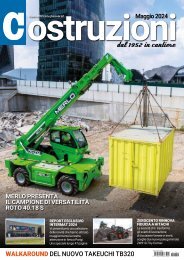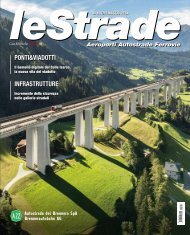leStrade n. 1589 luglio 2023
INFRASTRUTTURE Ponte sul fiume Po della carreggiata nord dell'Autostrada A7 PONTI L'esperienza del ponte ciclo-pedonale di Podgorica in Montenegro
INFRASTRUTTURE
Ponte sul fiume Po della carreggiata nord dell'Autostrada A7
PONTI
L'esperienza del ponte ciclo-pedonale di Podgorica in Montenegro
- No tags were found...
Create successful ePaper yourself
Turn your PDF publications into a flip-book with our unique Google optimized e-Paper software.
Obiettivi<br />
Prestazioni e vantaggi<br />
sostenibili<br />
MasterCO 2<br />
re TM : sistema di cluster<br />
intelligenti per calcestruzzi a ridotto<br />
contenuto di clinker<br />
Con un consumo globale di 13,5 miliardi di metri<br />
cubi, il calcestruzzo è di gran lunga il materiale<br />
artificiale più utilizzato. Unisce resistenza meccanica<br />
a compressione, durata e libertà di progettazione<br />
a una notevole disponibilità a livello<br />
globale. Il calcestruzzo è una miscela di cemento,<br />
acqua, sabbia e ghiaia. Il cemento è il legante<br />
che unisce tutti i costituenti del calcestruzzo,<br />
conferendogli le proprietà che lo caratterizzano.<br />
Le moderne formulazioni di calcestruzzo comprendono<br />
anche additivi chimici che conferiscono<br />
al materiale proprietà distintive sia allo stato<br />
fresco che a quello indurito.<br />
Il clinker è il componente principale del cemento<br />
e viene prodotto bruciando materie prime naturali<br />
come calcare, argilla e marna a temperature<br />
molto elevate. Questo processo è responsabile<br />
della maggior parte delle emissioni di CO 2<br />
del<br />
cemento. Anche se il clinker rappresenta generalmente<br />
solo circa il 10% del volume del calcestruzzo,<br />
è responsabile fino al 90% delle emis-<br />
sioni di CO 2<br />
legate al calcestruzzo. Ridurre la<br />
percentuale di clinker nel calcestruzzo è, quindi,<br />
un obiettivo cruciale per rendere l’edilizia più<br />
sostenibile in futuro. Tale obiettivo può essere<br />
raggiunto principalmente in tre modi: utilizzando<br />
tipi di cemento a ridotto contenuto di clinker;<br />
riducendo ulteriormente il contenuto di cemento<br />
nella miscela; sostituendo una parte significativa<br />
del cemento con materiali cementizi supplementari<br />
(SCM).<br />
Se il basso contenuto di clinker racchiude il maggior<br />
potenziale di riduzione delle emissioni di CO 2<br />
del calcestruzzo, pone di contro grandi sfide a chi<br />
lo produce. Il filler calcareo e gli SCM sono buoni<br />
sostituti dei leganti cementizi, ma differiscono dal<br />
clinker per superficie specifica e variazioni qualitative,<br />
con conseguenti effetti sulle prestazioni<br />
del calcestruzzo. La perdita di lavorabilità, il peggioramento<br />
della reologia e la riduzione della resistenza<br />
meccanica a compressione sono i principali<br />
effetti indesiderati che si possono verificare.<br />
English Version<br />
Sustainable Concrete Performance<br />
MASTERCO 2<br />
RE TM : INTELLIGENT CLUSTER SYSTEM<br />
FOR LOW-CLINKER CONCRETE<br />
With global consumption of 13.5 billion m 3 , concrete is by far the most widely<br />
used man-made material. It combines durability, strength, and design capability<br />
with impressive global availability. In its simplest form, concrete<br />
consists of cement, water, sand, and gravel. Cement is the binder that connects<br />
concrete’s primary constituents and provides it with its remarkable<br />
properties. Modern concrete formulations also incorporate chemical admixtures<br />
which impart distinctive properties to the material in both its fresh<br />
and hardened states.<br />
Clinker, the main component of cement, is produced by burning natural raw<br />
materials such as limestone, clay, and marl at very high temperatures. This<br />
process is responsible for most of the CO 2<br />
emissions of cement. Although<br />
clinker generally accounts for only about 10% of the volume of concrete, it<br />
is responsible for up to 90% of the CO 2<br />
embodied in concrete.<br />
Lowering the percentage of clinker in concrete is, therefore, a crucial goal<br />
to make construction more sustainable in the future. This can be achieved<br />
mainly in three ways:<br />
First, by using already clinker-reduced cement types; second, by further reducing<br />
the content of conventional cement; and third by replacing a significant<br />
portion of cement with supplementary cementitious materials (SCMs).<br />
While low-clinker concrete holds the greatest potential for CO 2<br />
reduction in<br />
concrete, it also poses major challenges for concrete producers. Limestone<br />
filler and SCMs are promising cement substitutes but differ in surface area<br />
and quality variations, leading to strong effects on concrete performance.<br />
Loss in workability, worsening of rheology, and reduction of strength are<br />
the main undesirable outcomes that frequently occur.<br />
MasterCO 2<br />
re TM<br />
MasterCO 2<br />
re TM is our product range for ready-mix and precast applications<br />
that addresses the performance gaps and limitations associated<br />
with challenging starting materials that conventional superplasticizers<br />
cannot overcome – simplifying your challenges and sup- porting your<br />
sustainable journey.<br />
Transforming construction requires rethinking familiar processes<br />
and deploying advanced solutions that pave the way to stay ahead<br />
of the industry. MasterCO 2<br />
re TM is a smart tech- nology based on an<br />
intelligent cluster system (ICS) that delivers its effects precisely<br />
when required. A portion of its freely available polymers is immediately<br />
dispersed for initial water reduction. The finely tuned chemi-<br />
Gli innovatori<br />
74 7/<strong>2023</strong> <strong>leStrade</strong><br />
<strong>leStrade</strong> 7/<strong>2023</strong> 75


















